WorldAnimalFoundation.org is reader-supported. When you buy through links on our site, we may earn an affiliate commission. Learn More
A mastiff and a Chihuahua walk into a bar …(Just a visual to make you giggle!) When you think of a mastiff, you think ‘humongous’ and ‘protective,’ and they are. They’re also gentle, docile, and excellent cuddlers.
Some think they’ve been around since the beginning of civilization. We can safely say the Grand Mastiff has been in existence for millennia and has survived many brushes with extinction. For example, during WWs I and II, people could barely feed themselves, much less a 100+ lb. dog, so many were lost.
They “fought” their way through tragedies and horrific circumstances, and today, there are more than 15 mastiff breeds in the world. We’re going to let you in on why these animals are unique and what they do again and again to steal our hearts.
So come along on this journey to study the big, bold, and beautiful – the mastiff.
Breed Characteristics
Every dog is unique, but these characteristics are general traits of mastiff-type dogs that have been recognized:
- Large
- Wrinkled
- Powerful
- Courageous
- Protective instincts
- Gentle
- Loyal
- Heavy-boned
- Droolers
- Masked
- Broad heads
- Broad short muzzles
- Droopy ears
- Short course coat
- Double-coated
- Short lifespan
- Working group
- Loving
What exactly is a mastiff? A stalwart canine, a noble creature, and one who somehow knows that strength of character trumps brute strength every time. Origin-wise, they’re truly a British baby.
Mastiffs were used as fighting and guard dogs for more than 2,000 years. Facts about this dog type were recorded by Europeans and Asians dating back to 3000 BCE. Over the years, they have played many roles:
- Military dogs
- Police dogs
- Watchdogs
- Guard dogs
- Search and rescue
- Hunting dogs
- Show dogs
- Therapy dogs
- Companions
They were also, unfortunately, fighting dogs when the Romans invaded England and took them back to spar against lions, tigers, bears, bulls, other dogs, and even human gladiators.
In the late 1800s, mastiffs were imported to America in large numbers. Frankly, they have been used to fight each other and other dogs by unscrupulous people but are mainly enjoyed as companions and show dogs.
Fun fact: In 1987, an Old English Mastiff named Zorba won the Guinness World Record for being the longest and heaviest dog ever recorded at 8’3” nose to tail and weighing 343 lbs.
Mastiffs have a low energy level, and that, coupled with their propensity for joint issues, makes them a better partner for low-key exercise than, say, jogging.
Now, let’s get into the meat of the article… The list of mastiff dog breeds.
Mastiff Breeds
Let’s meet the Mastiffs – known as guardian breeds and gentle giants with a penchant for power and cuddles. Let’s explore the seven breeds that wear both hats with pride.
1. Mastiff (English Mastiff)
| Group | Working |
| Height | 27.5” – 30”+ |
| Weight | 120-230 lbs. |
| Fur & color | Double-coated – Apricot, brindle, fawn |
| Lifespan | 6-10 yrs. |
An old French word, “mestif,” meaning mongrel, influenced the word “mastiff.” This extremely loyal dog breed ranks high on the list of excellent companions with the right person/people.
They don’t mind kids, other dogs, or cats but should be socialized early to ensure it. They’re intelligent and eager to please and will calmly stay by your side since it’s inherent that they protect.
Mastiffs are an ancient breed. The dog we know today developed in medieval England as big-game hunters and protectors of people and property.
When the great (arguably) Julius Ceasar led the invasion of Britain in 55 BC, he was astounded by these enormous dogs. They were taken to Rome to participate in fighting rings against bears, bulls, lions, and the like. In the late 1800s, these Roman dogs arrived in America and were used to guard plantations.
They have the honor of being one of the first recognized breeds of the American Kennel Club (1885).
2. Bullmastiff

| Group | Working |
| Height | 24”-27” |
| Weight | 100-130 lbs. |
| Fur & color | Double-coated – Fawn, fawn brindle, red, red brindle, red fawn, red fawn brindle |
| Lifespan | 7-9 yrs. |
These guys adore children but are so huge you’ll need to supervise them at all times. Ideally, they’ll be cohabitating with older kids. Expect to spend a lot of time with this massive dog.
They love affection and their guardians, and time spent with you is what they dig the most. If you’re a neat freak at home, though, your furniture and clothes may suffer. Welcome to the bullmastiff’s drooly world.
These dogs don’t bark a lot, but when they do, everyone pays attention. To be the best companion possible, this breed needs continuous training (130 lbs. is a whole lotta dog) and plenty of early exposure to different people, animals, places, and things.
Boundaries and rules must be set in stone, or you could have a walking wrecking ball on your hands. They’re not big on their own kind and really need to be raised with another dog to keep the peace.
Bottom line on Bullmastiffs? You can never get enough of their peaceful and laid-back demeanor.
3. Neapolitan Mastiff
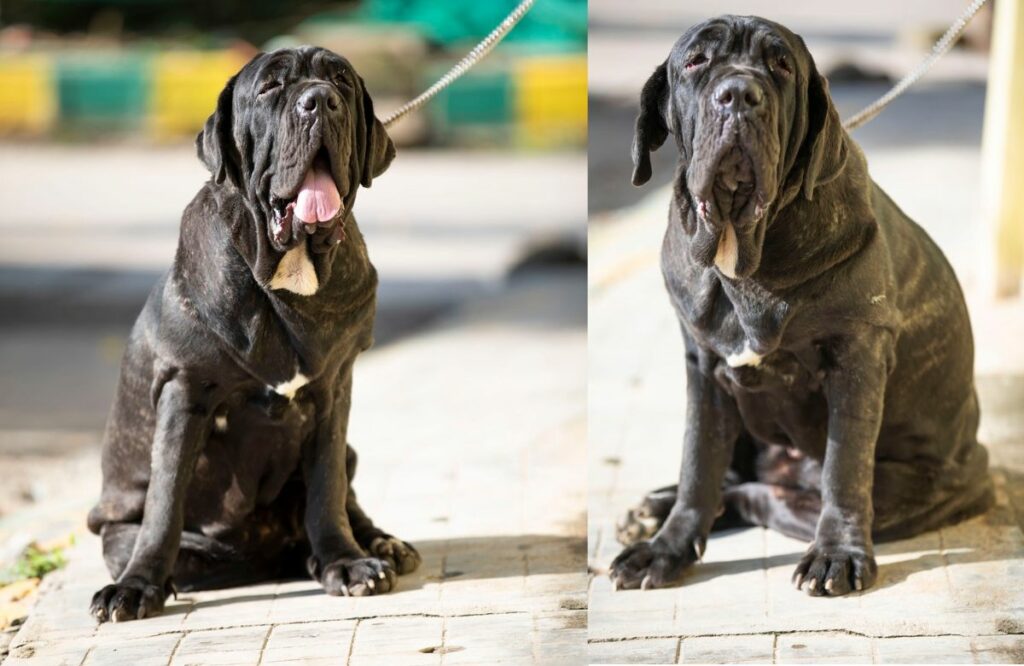
| Group | Working |
| Height | 24”-31” |
| Weight | 110-150 lbs. |
| Fur & color | Double-coated – Blue, black, mahogany, tawny |
| Lifespan | 7-9 yrs. |
Just because his wrinkly, stretched-out face looks like he’s looking in a carnival mirror, the Neapolitan mastiff is a gorgeous breed. According to the US Neapolitan Mastiff Club, they originated as dogs of war used by the Roman army. From there, they were used as estate and farm guard dogs in Italy.
Proof from paintings and statues dating from 3000 years before Christ shows that these mastiffs were war dogs of Egypt, Persia, Mesopotamia, and Asia.
After WWII, Italy claimed the breed as a treasured dog, which eventually led to its formidable presence in the modern world. And you won’t believe this – Alexander the Great (356-323 BC) played a huge role in creating today’s Neopolitan.
Today, this dog breed adores being with its human family. These Italian dogs are highly protective and gentle, and relaxation is high on their list of things to do. If you have plenty of time to spare to lounge and play in the backyard with this behemoth of a dog, this is your breed.
4. Dogue de Bordeaux (French Mastiff)
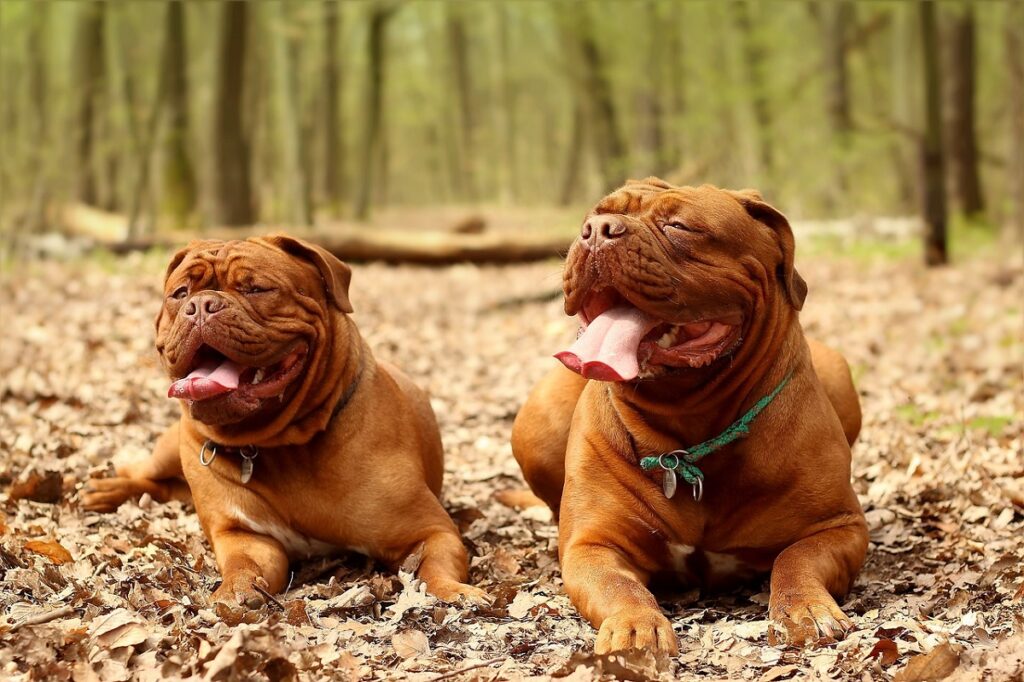
| Group | Working |
| Height | 23”-24” |
| Weight | 99-110 lbs. |
| Fur & color | Double-coated – Fawn, mahogany, Isabella, red |
| Lifespan | 5-8 yrs. |
“Powerful,” “Affectionate,” and “Courageous” are three perfect descriptions for this mastiff. Just looking at their solid, stocky stature can send a grown man running. Having one of the largest heads in the dog world, you can see why he makes such an imposing guard dog.
This breed originated in France in the 14th century and is named after the region where it was developed. They’re France’s oldest breed. Fast forward to recent years, the Dogue de Bordeaux came to America in 1959. And then, in 1989, there was a little movie called Turner and Hooch, with Tom Hanks, that made him a star.
France and North America both had hands in reviving the Bordeaux mastiff, and in 2008, the American Kennel Club (AKC) recognized them. These extremely patient dogs are wonders around children but should always be supervised when together.
Although they’re not aggressive, they don’t tolerate small pets well and might be best suited to live in a home with no other animals. Otherwise, there’s no doubt about it… He’s a good boy!
5. Tibetan Mastiff
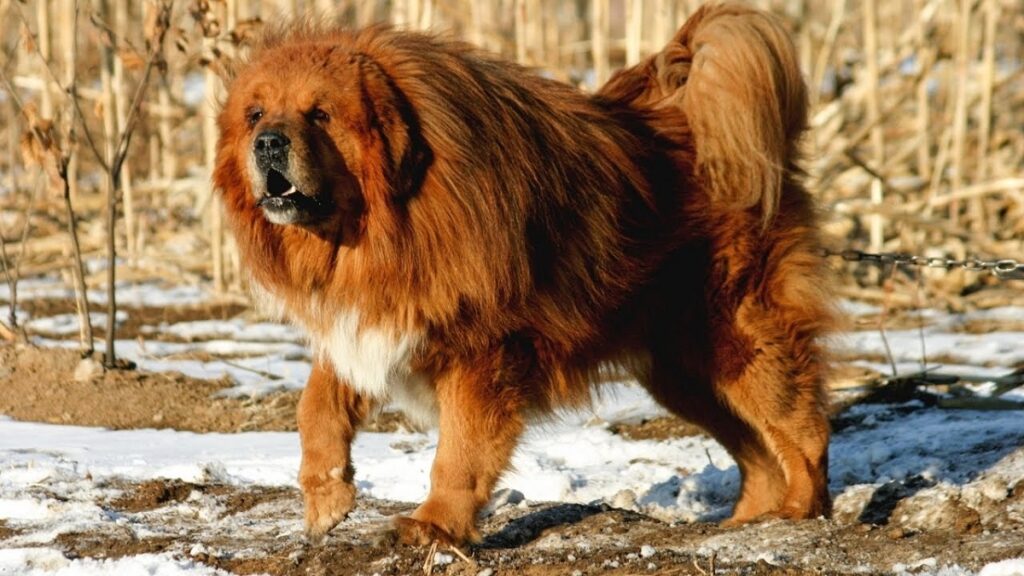
| Group | Working |
| Height | 24”-26” |
| Weight | 70-150 lbs. |
| Fur & color | Double-coated – 10 colors and color mixtures |
| Lifespan | 10-12 yrs. |
Tibetan mastiffs are one of the most beautiful dogs in the world, even if beauty is in the eye of the beholder. These beauties with lion-like manes can simultaneously look cuddly and intimidating. But you can be sure their one true desire is to be with their people.
Having a longer life expectancy than most mastiffs is just one of the differences that make this breed stand apart. They have the massive heads and impressive jowls of their mastiff cousins, but they’re drenched in so much hair that they’re tough to see.
Being the guardian of Tibetan Mastiff requires great thought and consideration. Food and vet costs, fencing, yard space, grooming, and their size are a few things to think about. Can you afford it? If so, and you have the time to give to them, your heart and home will thank you.
6. Boerboel (South African Mastiff)
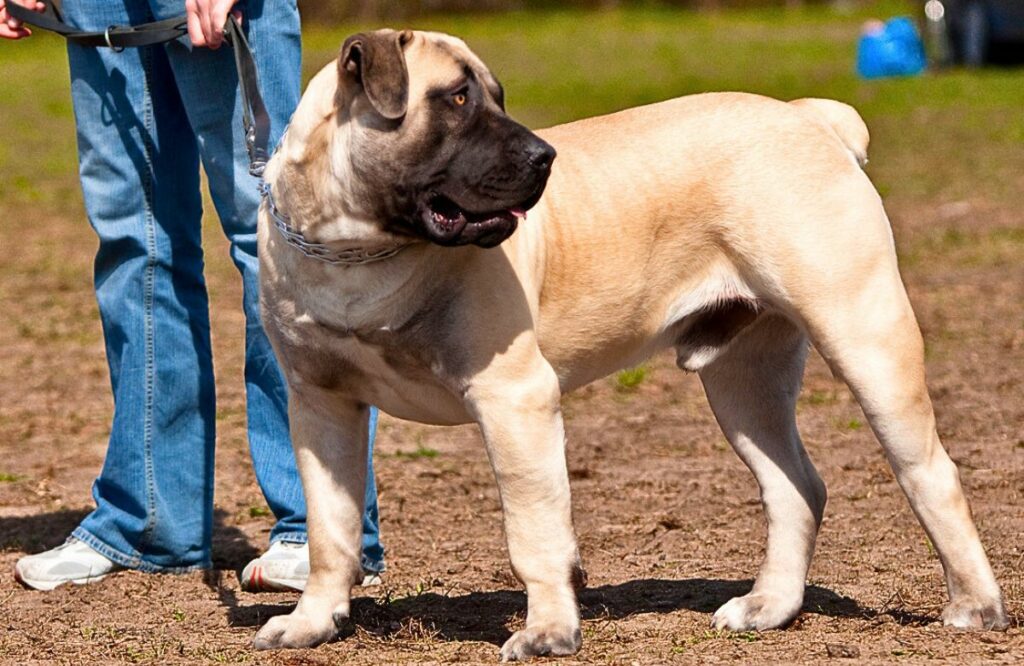
| Group | Working |
| Height | 22”-27” |
| Weight | 150-200 lbs. |
| Fur & color | Double-coated – Brown, brindle, cream, tawny, reddish brown, red |
| Lifespan | 9-11 yrs. |
These big guys (and gals) are awesome therapy dogs, particularly for children. Boerboels (pronounced bor-bull), which means “farmer’s dog,” protected settlers of South Africa in the 1600s. They don’t know fear and use that against predators like lions and baboons.
They’re probably the most agile of mastiffs and are as confident as they are intelligent. Boerboels are reliable watchdogs who need daily walks.
Don’t plan on visits to the dog park though, since chit-chatting with other dogs isn’t high on his list of things to do. He doesn’t like to be challenged. Overall, he’s a terrific family dog.
7. Cane Corso (Italian Mastiff)
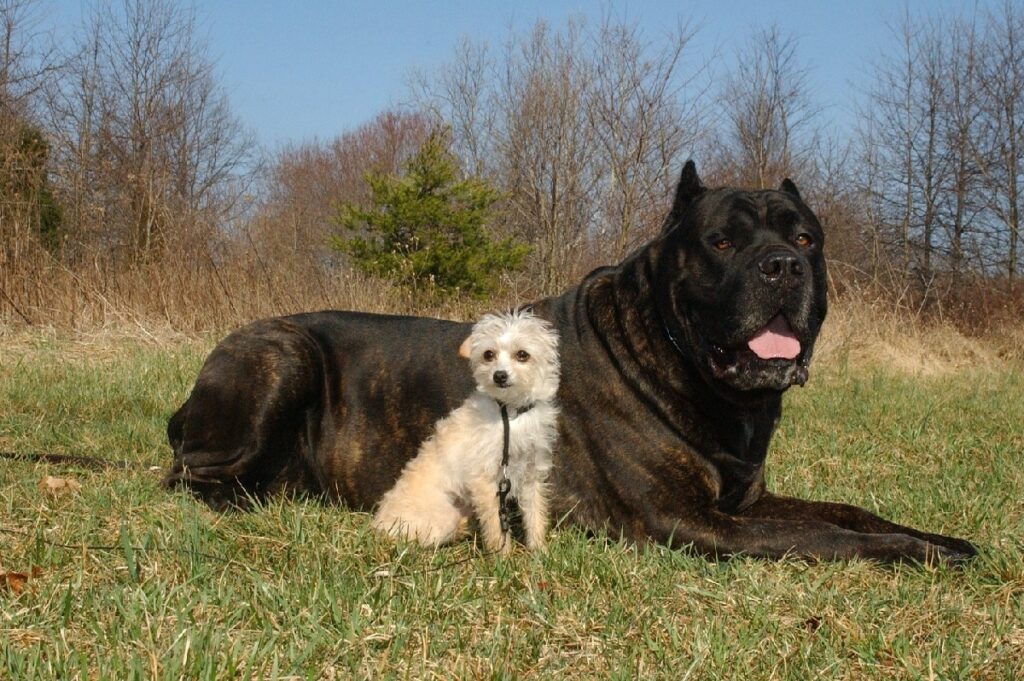
| Group | Working |
| Height | 23.5”-27.5” |
| Weight | 88-110 lbs. |
| Fur & color | Double-coated – Black, gray, fawn, black brindle, gray brindle, red, chestnut brindle |
| Lifespan | 9-12 yrs. |
The Cane Corso (pronounced Kah-nay Corso) isn’t innately aggressive. Similar to pitbull terrier breeds, they’ve been exploited and used in the fighting ring ad nauseam. If you’ll notice, their natural ears are floppy, but many you see have had their ears cropped (boo!) just to look menacing (much like Dobermans).
Their list of roles includes:
- War dog
- Farm dogs
- Guard dogs
- Large-game hunters
- Companions
If you’re committed to being a consistent (lifetime) trainer and one who teaches socialization skills to your Cane Corso, this protective companion will become your best friend.
Health and General Care of Mastiff Dog Breeds
You’d think a dog as ginormous as a mastiff MUST be more difficult to care for than other breeds, right? Not so much.
- Regular, twice-a-week brushing will keep their dense coat healthy and promote essential oils for their skin.
- Keep their skin folds (wrinkles) clean and dry.
- Bathe them every couple of months. You don’t want to dry out their skin, and with their short coats, they don’t get too dirty under normal circumstances.
- Have their nails trimmed regularly. They’re carrying around a lot of weight, and those paws need to be cared for.
- Make sure they always have fresh water.
- Try to serve them fresh food like subscription-based meals – meat and vegetables.
- Make sure you take them to the vet twice a year. Mastiffs have specific ailments like cherry eye and joint issues that need to be monitored.
- Always train for obedience and socialization early and often.
FAQs
Which Mastiff Breed Is Known for Its Gentle Temperament?
The majority of mastiff breeds are gentle.
How Many Different Types of Mastiffs Exist?
There are over 15 types of mastiff breeds.
Which Mastiff Breeds Are Low-Shedding?
Although their hair is dense, most mastiffs are low-shedders except for twice a year when their double coats may heavily shed.
Final Thoughts
I’m a huge fan of big dog breeds, and these particular dogs are extra snuggly. Mastiffs are magnificent companions, so go research a breed-specific rescue now to find a creature that will change your life.
And as life happens, large dogs are great to take out and about with you. Mastiffs will enjoy the change of scenery. Tip? Bring a rag.

